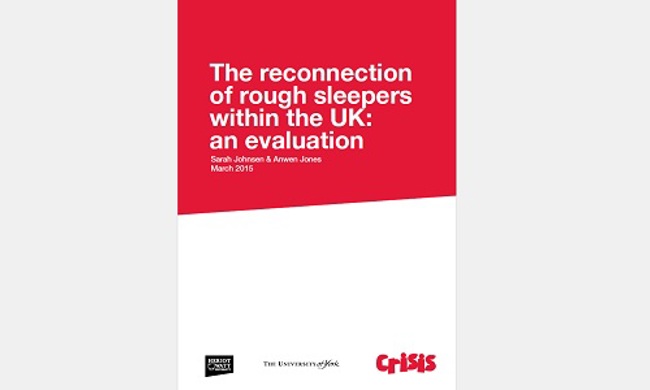The reconnection of rough sleepers within the UK: an evaluation (2015)
01.03.2015
‘Reconnection’, defined in policy terms as the process by which people sleeping rough, who have a connection to another area where they can access accommodation and/or social, family and support networks, are supported to return to this area in a planned way.
Key findings
- Reconnection, defined in policy as ‘the process by which people sleeping rough who have a connection to another area … are supported to return to this area in a planned way’ has become an increasingly prevalent feature of rough sleeping strategies in England in recent years, albeit largely in the absence of robust evidence regarding the impacts on rough sleepers. Evidence regarding reconnection outcomes is, at present, very weak.
- Inter-city reconnections, that is, the reconnection of British nationals from one urban centre to another within the UK, comprise the majority of reconnections from some areas. In London, these are outnumbered by international reconnections (involving moves abroad) and intra-city reconnections (from one borough to another). This study focused on within-UK (inter-city and intra-city) reconnections only.
- Reconnection is an umbrella term used to refer to a wide range of approaches, including: ‘reconnection (proper)’ which supports rough sleepers to return to somewhere they have an established link; ‘diversion’ which supports them to access services somewhere else where they do not have a connection; and ‘deflection’ wherein they are advised to return ‘home’ but are not provided with support to do so.
- National guidance outlining agreed good practice exists, but implementation often deviates from this quite substantially. Resource and time pressures dictate that assessments of rough sleepers’ connections and support needs are often extremely limited. Furthermore, support is in some cases intensive and tailored; but in the greater majority of cases is minimal.
- In practice, connections are almost always assessed in terms of the Homelessness Code of Guidance for Local Authorities ‘local connection’ criteria. In some places, the last place of settled residence (where someone has lived for six out of the last 12 months or three out of the last five years) is regarded as ‘trumps’ and other criteria have little influence; in others weighting is given to other forms of local connection (e.g. having adult family members living in the area).
- Outcomes are only recorded in a small minority of cases. The limited data available suggest that reconnection experiences and outcomes vary dramatically, from positive (e.g. accessing accommodation and re-engaging with support services) to negative (e.g. sleeping rough in the recipient area because the services offered are of poor quality or time limited).
- Practitioners generally agree that reconnection is wholly appropriate and potentially beneficial in some circumstances, most notably where rough sleepers have made an unplanned move and abandoned ‘live’ supportive connections or services in so doing. Positive outcomes are more likely when good practice principles are adhered to, but are by no means guaranteed.
- The limits and risks associated with reconnection raise significant ethical questions, especially as regards: denial of services to rough sleepers with no recognised local connection anywhere in the UK; uncertainty regarding the legitimacy and/or severity of risk to rough sleepers in recipient areas (especially when no proof in the form of police records exist); inadequate service responses in some recipient areas; and the fragility or lack of support networks in recipient areas.
- These ethical dilemmas are most acute when reconnection is employed as a ‘single service offer’, wherein rough sleepers who refuse to comply are denied access to homelessness services in the identifying area.
- These issues are profoundly important given indications that some local authorities are beginning to regard all single homeless people (not just rough sleepers) as potential reconnection cases and/or are tightening local connection criteria. If such trends are indicative of a more widespread ‘raising of drawbridges’ under localism it may become increasingly difficult for single homeless people to provide evidence of connections and access services.
Reference
Johnsen, S. & Jones, A. (2015) The reconnection of rough sleepers within the UK: an evaluation. London: Crisis.

